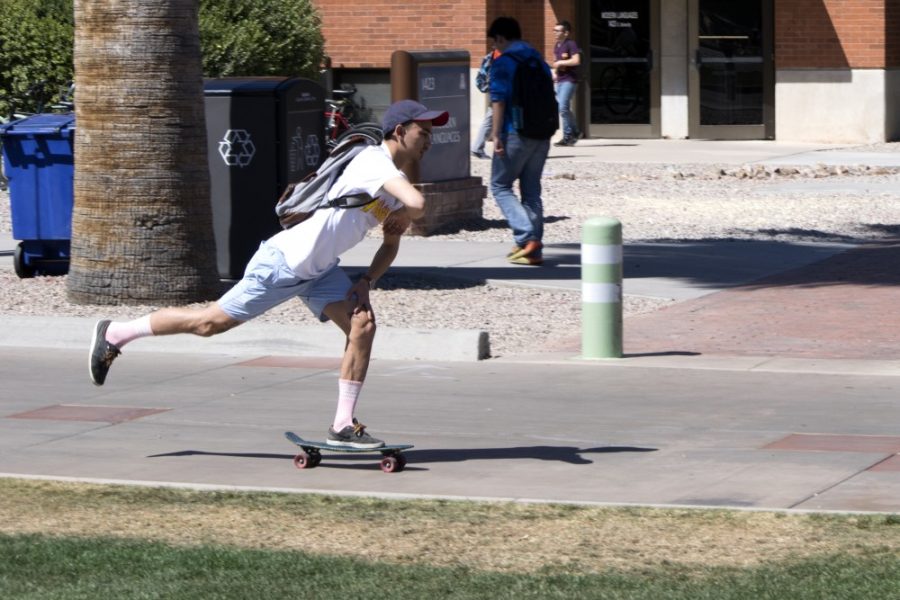We’ve all seen them around campus: students pushing their skateboards, longboards and penny boards around in a technique that looks like the board is towing the skater along and he or she is desperately pushing to keep up.
This is called pushing mongo. Mongo-pushers use their front foot to push the board forward, while their back foot remains on the back of the board. The other type of pushing, known as regular pushing, is when a skateboarder pushes the board forward with their back foot, while their front foot rests near the front-center of the board.
Pushing, stance and style differ greatly between longboarders and skateboarders. Some longboarders, especially downhill riders, prefer to push mongo because they believe they gain momentum and aerodynamics. In Tucson, however, there are few hills around campus. Here are seven reasons riders should stop pushing mongo:
1. It looks silly
Riders push mongo to try to steer their board while pushing, which is risky and looks extremely whacky. If you don’t want to look inexperienced, like you are snowshoeing on concrete or cross-country skiing with a single ski, stop pushing mongo.
Kyle Joyner is a local Tucson skater who rides for the BLX Skateshop team. Joyner said he has been skateboarding for about 18 years and riding for the BLX team for about four years. His stance has been regular since day one, meaning he leads with his left foot.
Joyner mainly does street skating, with a little transition mixed in, and he occasionally rides longboards for transportation. Joyner pushes regular, with his back foot.
“First of all, it’s the right way to push because it’s easier to control, you go faster [and] you won’t fall as easily,” Joyner said. “It looks way better; mongo just looks ugly.”
2. It’s a bad habit
Joyner said he pushed mongo for almost two years when he first started skating.
“At first it was not easy to get used to pushing regular,” Joyner said. “If you force yourself and just keep pushing with that foot, you’ll get used to it and it will be your dominant foot.”
Joyner said riders looking to switch to pushing regular from mongo have to work on riding that way.
“You’ve just got to force yourself into it; you’ve just got to do it cold turkey,” Joyner said.
RELATED: Nitro Circus Live flips its way into Tucson

3. It can be harder to stay steady
If riders encounter a rock or crack and fall while pushing mongo, their board is likely to shoot out in front of them and take out the ankles of the unfortunate pedestrian walking in front of them. If riders take a spill while pushing regular, they may be able to just hop off, or at least not have to witness the maiming of the ankles belonging to the pedestrian walking behind them.
Anna Aloma, a sophomore studying chemical engineering, has been skating for about a year; she uses a longboard to commute to class. Aloma pushes regular, and her stance is goofy, meaning when she rides forward, her right foot is in the front of the board.
Aloma said if she pushed with her right (front) leg she would feel like she was going to fall off.
“I trust my right leg to [stay] on the board; I just feel more stable that way,” Aloma said.
4. Style matters.
Skateboarding is like weight lifting; it’s a personal sport. If you push mongo and you are a skilled rider, keep doing you.
However, style is a very important part of skateboarding. The Street League Skateboarding competition accounts style points into scoring of their Run Section competition.
In Tony Hawk’s Trick Tips Vol. 1, a VHS instructional video released in 2000, Hawk said mongo pushing is the most common pushing mistake you can make in skateboarding.
“You get much less control; you don’t get as much speed; you have to set up your feet more when you stop the push, and we do not recommend it,” Hawk said in the video.

5. Pushing mongo is bad for all board types
Think about it: When snowboarders finish a run they unclip their back foot from their bindings and use that foot to push themselves over to the next lift. It’s easier to use your front foot to pull the board along than it is to push the entire board forward with your back foot.
The same goes for longboarding or penny boarding. If you gain momentum by pushing with your back foot, once you step on the board you will only need to correct your back foot for maneuverability or balance correction.
UA student Albert Kline said he has been skateboarding for about six years, on and off. He said he uses a penny board to commute between classes because it’s a little easier. Kline’s stance is regular, and he pushes regular.
“It’s just the right way to push, man,” Kline said. “If you want to get around fast and have smooth turns, it’s the only way to skate.”
When riders push mongo, they have to step their front foot back on the board, and then reset their back foot into a better position. Why add the extra step when you can set your front foot, push, step your back foot on the board and maybe add minor adjustments to your front foot.
“Set the front foot a little behind the front truck, and the back foot wherever it feels comfortable,” Kline said. “Learn how to push regular; it’ll help you out in the long run.”
RELATED: Wild west meets steampunk at Tucson convention
6. The pros don’t push mongo
Very few professional skateboarders push mongo; skateboarder Terry Kennedy is among the few.
Chris Cole, a professional skateboarder who ranked 12th place in SLS in 2016, used to push mongo. Cole has made 77 percent of all SLS finals since the competition began in 2010, and has qualified for five of six Championship contests as an SLS pro.
According to the documentary “Motivation 2: The Chris Cole Story” Cole was told by Jamie Thomas, owner and founder of Zero Skateboards, that he needed to stop pushing mongo in order to be signed by Zero.
7. Weight for it…
The concept of weight distribution is similar to towing a trailer behind a truck. The weight and power should be in the front, pulling the trailer along. You wouldn’t put the trailer in front of your truck and push it along that way, would you?
Most load-bearing motor vehicles, such as trucks and SUVs, operate with rear wheel drive and front wheel steering, although many have four-wheel-drive or all-wheel-drive functions. A steering wheel turns the front wheels, and the back wheels are powered through a driveshaft which transmits the engine’s power to the back wheels.
Skateboarding should work the same way. Pushing with your back foot powers the boards movement, while the front foot maneuvers the front truck and wheels for turning during a push.
One exception to the regular pushing rule is when a skater is riding switch, or riding with their non-dominant foot in the front of the board. When you have a short distance to push before setting up for a trick, many pro skaters will push mongo to allow their back foot more stability before popping the tail down to perform a trick.
So, if you are a beginner at skateboarding, don’t start off on the wrong foot. Don’t push mongo.
If you need pseudo-mnemonic device to help you remember which pushing technique is the proper one, just remember this: mongo is wrongo.
Follow Isaac Andrews on Twitter.









